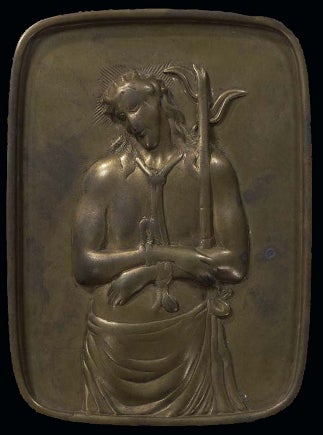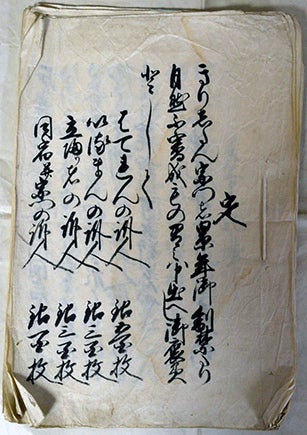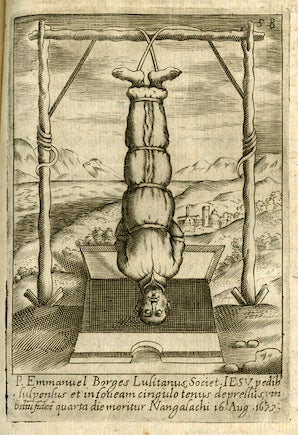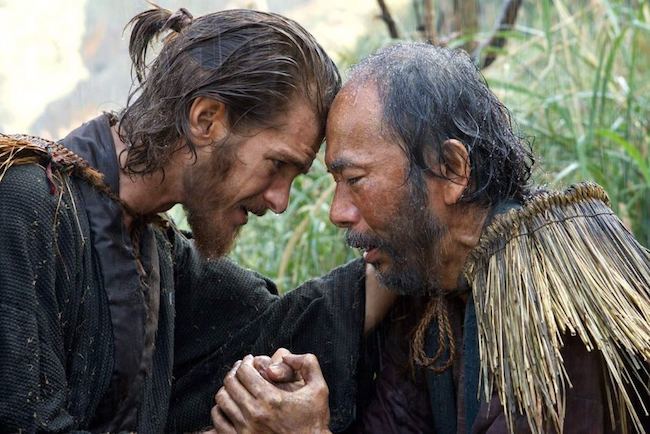
A “fumi-e” (”trample image”). The population was forced to trample each year on a Christian image to indicate they were not Christians.
The wait is over. The long anticipated film adaptation of Japanese author, Endō Shūsaku’s novel Silence by director, Martin Scorsese, has just been released in the U.S. on December 23. A work of fiction, Silence tells the true story of Christian persecution in 17th-century Japan under the iron rule of the Tokugawa shoguns. Scorsese calls it his “obsession” and has been working for nearly three decades to bring the film to the big screen.

A decree banning the Christian faith and offering rewards to anyone who denounces missionaries or Christian believers (”500 pieces of silver for a priest”)
A True Story in the Japan of the Shoguns
Jesuits, the worldwide Catholic religious order of priests and brothers, figure prominently in the story. By the 1620s, the golden age of the Japanese missionary enterprise, founded by the Jesuit missionary St. Francis Xavier, had passed, and missionaries had been officially expelled from Japan. A number of priests, however, went underground to minister to the vibrant Christian community that was struggling to survive against all odds. Among them was Fr. Cristóvão Ferreira, the Portugese provincial superior of the Jesuit mission, who in 1633 renounced his faith while undergoing one of the most barbaric forms of torture ever devised—the torture “of the pit”.

Image of a Portuguese Jesuit who died in the “pit” in Nagasaki in 1633.
To atone for the sin of his public apostasy, the Jesuits sent several groups of missionaries to Japan to persuade Ferreira to reconcile with his own conscience and with the Church. These men knew that they would be apprehended, tortured, and killed. This is all part of the drama of Jesuit history.
Endō’s Novel and Scorsese’s Film
In the novel, the missionaries sent to Japan are given the fictional names, Rodrigues and Garrpe. After Rodrigues is arrested and brought before Ferreira, who now works for his captors, he is faced with an impossible choice: either trample on a sacred image (fumi-e) of Christ to signify his own apostasy or watch a group of Japanese Christians die a slow, hideous death in his stead.

A scene from Martin Scorsese’s “Silence” (2017).
Wracked with doubt and anguish and faced with an impossible dilemma, while God remains mysteriously “silent”, Rodrigues finally succumbs to the inquisitor’s demand. He defaces an image of Christ by stepping on it to alleviate the terrible suffering of the Japanese Christians. Immediately thereafter he hears the cock crow—as Peter did after he had denied three times that he knew Jesus. But paradoxically, at the very moment when he falls into apostasy and loses his own dignity and self-respect, Rodrigues hears an echo of the merciful voice of God.
At no point does Endō condone or equate apostasy with the “new normal”. Rather, he concentrates on an understanding of Christian faith marked by suffering and divine mercy. The novel reminds us of a Zen kōan, a short, pithy saying that presents the Buddhist novice in training with a seemingly absurd or contradictory statement, whose purpose is to free the mind from the illusion that rationality alone can penetrate the depths of truth. Not everything is black and white. Enlightenment lie elsewhere.
A Drama for our own time
Four hundred years after the real events took place and fifty years after Silence was first published in 1966, Endō’s novel remains a most uncomfortable and disconcerting story of heroism and betrayal. As ethnic, racial, and religious intolerance and violence continue to mark our own time, Endō’s novel invites us to reflect on what exactly it means to have faith in a world full of anguish and suffering.
In the year that saw “post-truth” enter the Oxford English Dictionary as a new word, how do we—both as individuals and as a commonwealth of societies and nations—find what is true and good? It is this stark and timeless drama of the human condition that served as the backdrop and inspiration for both Endō’s story and Scorsese’s cinematic re-telling of Silence for our own time. The questions are haunting.
Having set off for Japan thirty-one years ago as a young and enthusiastic Jesuit missionary, I cannot help but be haunted by a simple yet painful question: Had I been born in 1564 rather than 1964 and found myself in Rodrigues’s shoes, What would I have done?